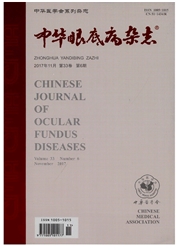

 中文摘要:
中文摘要:
目的观察急性黄斑神经视网膜病变(AMN)的临床特征。方法经眼科常规检查、近红外反射(IR)、频域光相干断层扫描(SD-OCT)、荧光素眼底血管造影(FFA)检查确诊的6例AMN患者11只眼纳入研究。有登革热病史5例9只眼,占患眼的81.8%;有头部外伤史1例2只眼,占患眼的18.2%。6例患者中,1例患者因合并双跟视盘轻度水肿,给予VI服糖皮质激素治疗;其余5例患者均以观察为主。所有患者每2周复查1次,直至6个月结束随访观察。每次复查均行眼底彩色照相、FFA、IR和SD-OCT检查。结果患者眼部症状主要表现为突发单眼或双眼一个或多个中心或中心旁暗点。眼底彩色照相检查发现,眼底表现正常1只眼;黄斑区楔形病灶2只眼;片状黄白色或棕色病灶8只眼。FFA检查发现,所有患眼AMN病灶均无异常表现。IR检查发现,所有患眼表现为局灶性弱反射病灶。SD-OCT检查发现,所有患眼光感受器层可见局灶性强反射病灶,并使其正常反射结构中断。强反射病灶于初诊后2周内开始消退,初诊后24周时仍可残留少量于Henle纤维层。随着光感受器层强反射病灶的消退,外核层出现不可逆变薄,外界膜和椭圆体带开始修复,两者的连续性于随访终点基本恢复,但交叉区连续性仍然中断。整个随访期间所有患者中心或旁中心暗点持续存在。结论AMN特征性表现为IR弱反射病灶;SD-OCT初诊时表现为光感受器层局灶性强反射,随访末表现为交叉区连续性中断;中心或旁中心暗点症状可持续存在至少6个月。
 英文摘要:
英文摘要:
Objective To observe the clinical features of acute macular neuroretinopathy (AMN). Methods Six patients (11 eyes) with AMN were included in this study, with every 2-week follow-ups till six months. Among them, five had preceding dengue fever (83.3%), one had history of head trauma (16.7%). All patients received routine examination, fundus photography, infrared reflectance (IR) imaging, spectral-domain optical coherence tomography (SD-OCT) scanning and fluorescein fundus angiography (FFA) initially, and fundus photography, IR, SD-OCT during follow-up. Results Sudden onset of central/paracentral scotoma in one eye or both eyes was the main visual symptom. There were 1 eye with normal fundus, 2 eyes with wedge-shape lesions, 8 eyes with yellow-white or brown sheet lesion. IR imaging demonstrated localized areas of hypo-reflection in the macula. SD-OCT scanning through these areas revealed hyper-reflection in the photoreeeptor layer and disruption of its normal reflective structures. Subsequent SD-OCT demonstrated that the hyper-reflection of the photoreceptor layer regressed gradually, followed by thinning of the outer nuclear layer. The external limiting membrane and ellipsoid zone became continuous; however, the interdigitation zone was not restored. There was no remarkable findings of the AMN lesions on FFA. The scotomas persisted in all 6 patients (11 eyes) by the last visit. Conclusions IR imaging demonstrated localized areas of hypo-reflection in the macula. SD-OCT revealed hyper-reflection in the photoreceptor layer in acute stage and the interdigitation zone was not restored in late stage. AMN has a relative poor prognosis with persistent scotomas through at least 6 months.
 同期刊论文项目
同期刊论文项目
 同项目期刊论文
同项目期刊论文
 期刊信息
期刊信息
